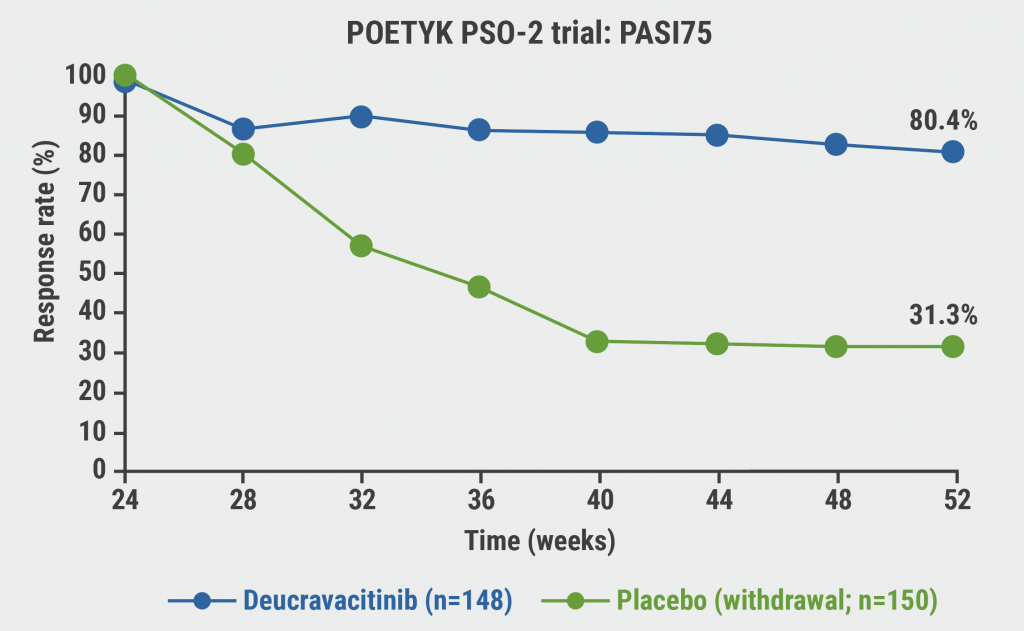Approximately 1% of all children and adolescents suffer from psoriasis. Although children are less likely to develop the disease than adults, their suffering is particularly severe as the condition negatively impacts their quality of life. In addition, it affects their long-term psychological well-being. The IL-17 blocker secukinumab has been proven to be efficacious in children 6 to <18 years of age in 2 phase 3 trials [2,3]. In these studies, children (aged 6 to <12 years) and adolescents (aged 12 to <18 years) received either 75 mg or 150 mg of secukinumab, depending on their body weight (<50 kg or ≥50 kg). The biologic improved skin symptoms and quality of life at all doses studied. This led to its approval for children aged between 6 and <18 years with moderate-to-severe psoriasis.
The issue of safety is of particular interest when it comes to children and adolescents. To explore this further, pooled safety analyses of the 2 phase 3 studies (NCT02471144 and NCT03668613) evaluated all patients who received at least 1 dose of secukinumab. Prof. Michael Sticherling (University Erlangen–Nürnberg, Germany) presented 2 analyses: one on the safety data up to week 12, and the second with data up to week 52 [1].
The safety profile of secukinumab was comparable in both studies and was consistent with that seen in adults with plaque psoriasis. In the 12-week analysis, infections (particularly nasopharyngitis) were most common. Infections occurred in 31.7% of children treated with the low dose of secukinumab and 35.4% with the high dose of secukinumab compared with 39% with placebo. In addition, gastrointestinal disturbances occurred in 8.5% of patients treated with the low secukinumab dose and 14.6% treated with the high secukinumab dose.
By week 52, 74.2% of children in both secukinumab groups reported adverse events (compared with 82.9% of children treated with etanercept). The incidence of serious adverse events was 6.6% in any secukinumab-treated children compared with 12.12% of those treated with etanercept (see Figure). Infections were also most common at 1 year (in 58.1% of all patients treated with secukinumab compared with 65.9% on etanercept therapy), followed by skin and subcutaneous tissue disorder, gastrointestinal disorders, general disorders and administration site conditions, and respiratory, thoracic and mediastinal disorders. More paediatric patients in the etanercept group (34.1%) had gastrointestinal problems compared with children treated with secukinumab (18.4% in the low-dose group compared with 25% in the high-dose group), and 2% of children treated with secukinumab had Candida infections.
Figure: Adverse events in paediatric patients treated with secukinumab or etanercept by week 52. Modified from [1] AEs, adverse events; HC, high dose; LD, low dose; SAEs, serious adverse events; SEC, secukinumab; SOC, system organ class.
AEs, adverse events; HC, high dose; LD, low dose; SAEs, serious adverse events; SEC, secukinumab; SOC, system organ class.
In general, the safety profile of secukinumab-treated paediatric patients was comparable to that of the placebo group. There was also no significant difference between the 2 doses. In addition, no new or unexpected safety signals were identified in children and adolescents. The frequency of adverse events was comparable to those seen in an adult population. The proportion of patients with infections was also similar between the 2 paediatric age subgroups.
- Sticherling M, et al. Pooled safety analysis from two phase 3 studies of secukinumab in paediatric patients for up to week 52 with moderate to severe plaque psoriasis. P49, Psoriasis from Gene to Clinic 2021, 9–11 December.
- Bodemer C, et al. J Eur Acad Dermatol Venereol 2021;35:938–947.
- Magnolo N, et al. J Am Acad Dermatol Venereol 2022;86:122–130.
Copyright ©2021 Medicom Medical Publishers
Posted on
Previous Article
« High treatment success with ixekizumab in patients with psoriasis and diabetes Next Article
TNF inhibitor for immune-mediated inflammatory disease doubles the risk of paradoxical psoriasis »
« High treatment success with ixekizumab in patients with psoriasis and diabetes Next Article
TNF inhibitor for immune-mediated inflammatory disease doubles the risk of paradoxical psoriasis »
Table of Contents: PFGC 2021
Featured articles
Letter from the Editor
Guselkumab shows highest drug survival among systemic treatments
Genes in Psoriasis and Psoriatic Arthritis
HLA-C*06:02-positive patients on ustekinumab show higher drug survival in a real-world scenario
Protective factors identified against anti-drug antibody formation to adalimumab in psoriasis
Comorbidity in Psoriasis
Psoriasis associated with a higher cancer risk
Comorbidity and clinical features of psoriasis vary according to HLA-C*06:02 status
Psoriasis patients with cardiovascular comorbidity characterised by high systemic inflammation
Psoriasis Therapy: New Findings
Inhibition of heat shock protein: A novel way to treat psoriasis?
Guselkumab shows highest drug survival among systemic treatments
Tapering biologics: No alarming signs of increased anti-drug antibodies
Intermediate monocytes are possible predictors of response to secukinumab
Gut microbiota of psoriasis patients: less diverse and reduced functionality
COVID-19: What's New
DLQI scores underestimated during lockdowns?
TNF blockers likely beneficial for psoriatic patients with COVID-19
Patients on immunomodulators need 2 COVID-19 vaccinations before seroconversion
Paradoxical Reactions to Biologics
The Yin and Yang of opposing vectors: an explanation for side effects of biologics
Explaining arthropathy development through IL-4 and IL-13 blockade
Best of the Posters
Potential biomarker discovered for treatment response to ustekinumab
TNF inhibitor for immune-mediated inflammatory disease doubles the risk of paradoxical psoriasis
Secukinumab also tolerable in paediatric psoriasis patients
High treatment success with ixekizumab in patients with psoriasis and diabetes
Related Articles

August 26, 2022
Systemic treatment for psoriasis: what is on the horizon?
© 2024 Medicom Medical Publishers. All rights reserved. Terms and Conditions | Privacy Policy

